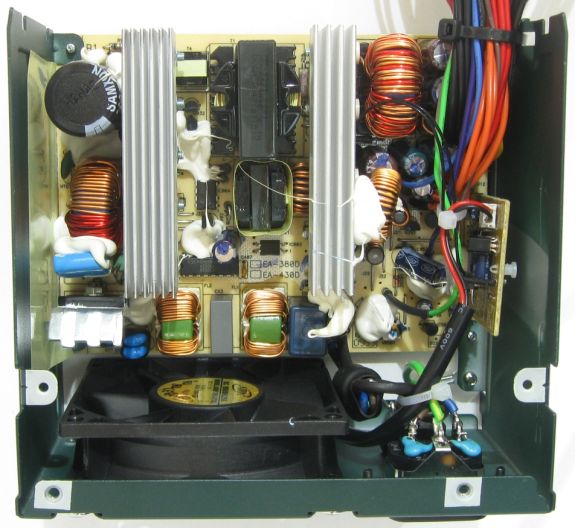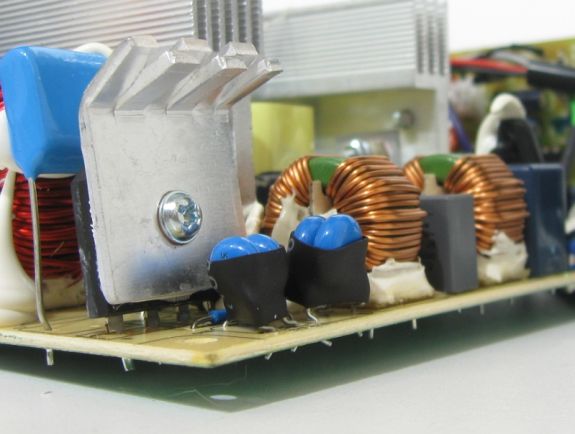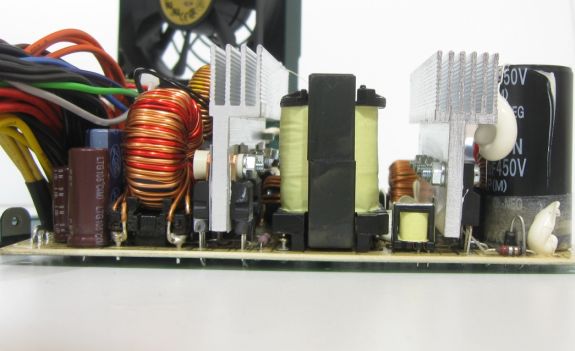Antec EarthWatts EA 380D Green 380W
by Martin Kaffei on October 2, 2010 7:00 PM EST- Posted in
- Cases/Cooling/PSUs
- PSUs
- Green
- Antec
- Earth Watts
- 380W
Internals
After opening the PSU, a well-structured design can be seen with two rather slim heat sinks, which are positioned according to the airflow. Similar to the first EarthWatts models (designed by Seasonic), the heat sinks don’t form a tunnel topology, which means that the airflow isn’t as linear as we have seen elsewhere--i.e. an Arctic Cooling PSU with their thoughtfully positioned air foil. But there is less energy dissipating into heat because of the lower nominal power and higher efficiency and there are large spaces inside where the air is able to circulate. The position of the rectifier bridge with its heatsink and the EMI-filter slightly hinder the airflow.
The IEC-plug is followed by the mains switch, which engages the phase conductor when thrown. Two Y-caps are connected with a protective ground wire, which is securely fixed on the case. Additional glue would be useful to improve mechanical stability. Well-twisted phase and neutral wires are coiled around an additional ferrite core and securely soldered. If wires are not twisted well, the connection could easily break. [Note: The quality in Chinese factories is still fluctuating.]
Two common mode chokes, four Y-caps, and two X-caps follow, with another X-type cap located behind the rectifier bridge; however, a varistor is missing. From this perspective we can see how precisely the chokes are fixed. In the power factor pre-regulator, we find a Samxon capacitor with the model number MXL. The Champion-IC 6800AG regulates the PFC and the main circuit of the PSU. This IC features OCP (Over Current Protection) and short circuit protection and has become popular because of its low-loss controlling.
Since the glue can’t always be positioned accurately, the 12V-choke is stabilised with a socket, which is useful at certain sizes. The costs are higher and the processing is more complicated. This kind of fastening is more likely to be found in high-end models. Sometimes this method is impossible, since the space is limited. The last model with this feature was the Enermax Revolution85+ 850W, where the size of the PFC-choke was the problem. In the OEM sector it is common to fix the components above necessity.
The +12V rail is filtered by Nippon Chemi-Con (KZE) and Ltec (LZG) capacitors, while on the smaller rails a potpourri of Nippon Chemi-Cons, Ltecs, and a single Taicon are used. A metering diode on a heat sink measures the temperature.
The noted build quality continues with a high soldering quality. Most conducting paths are cleanly soldered, but the output cables of the secondary circuit had to be cut so the wires don’t protrude too much under the PCB. Usually the manufacturer should be able to estimate the lengths of the wire when using THT-components. Connections could break if protruding wires are cut off. On the solder points of phase and neutral wires, solder residue can be found because of a very high soldering temperature, but there are no damages visible.














64 Comments
View All Comments
decto - Monday, October 11, 2010 - link
I've used and installed many of the older EA 380 units which are also 80+ rated and now a couple of these.You can power a lot with them, a 3Ghz Q6600 and power sucking Radeon HD2900 or how about Q6600 and 8800GTS G92 512MB SLI. Both ran fine for regular extended gaming sessions.
I currently have one in an X2 5000 home server with a nvidia 7025 itx mainboard. Consumption is around 40W at idle so a quick calculation later (77% net @ 38W) and It's £7 ukp ($11 usd) per year of waste electricity for 24 / 7 / 365 operation.
While pico PSU and mini itx can be more efficent, the cost of the hardware negates the energy savings over a typical system lifetime.
As per a previous post, it would be good to see an article for low power systems <50W and <100W as more of us are using a purpose built 'efficient' home server or media centre and the data to make environmental and TCO based buying decisions is very hard to find.
Congratulation on the real world review.
More please.
Spazweasel - Thursday, October 14, 2010 - link
Using the power supply calculator at http://extreme.outervision.com/PSUEngine with a typical moderate gaming build:Clarkdale i5 650 with a modest overclock (3.6ghz, 1.33v vcore)
4gb DDR3 RAM (2x 2gb)
GTX 460 1gb (single card)
1 SATA hard drive
1 DVD-RW
Using on-board audio
1 additional 120mm cooling fan
25% additional capacitor aging factor
Their recommended power supply? 392 watts.
Yeah. This power supply for a moderate gaming rig is JUST FINE. If you're running a high-end system, sure, get that 750w unit. But recognize that even among gamers, that's hardly the typical build. And really, this "alpha nerd" BS where people get sneered at because they're not running water-cooled +50% overclocks with quad-SLI video subsystems... we can do without that. Nice system, sure, but the degree to which someone gets to look down their nose at someone else isn't tied to FSB speed.
Matias - Wednesday, December 7, 2011 - link
For the record, this Antec Earthwatts 380D PSU is enough to power my overclocked i5 2500K, EVGA GTX 460 1Gb FPB, SSD, HDD, DVD-ROM and PCI soundcard. Runs Skyrim just fine.The video card requires 24A and this PSU gives up to 25A per rail before the OCP protecion kicks in.
Sure, no headroom whatsoever, but these current draws are already worst case cenario, so I guess there is no need for headroom.
mrawesome421 - Friday, May 17, 2013 - link
I don't know what I am more impressed with. This PSU or this review. Really, terrific job here.Great unit too. I use this to run my old XP box and its quite, reliable and I actually like the green paint job. I would totally buy this thing again for a future HTPC build. In fact, I know I will.
Great review man. Thanks.